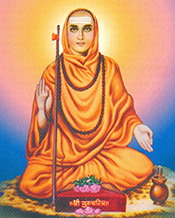P. P. Shree Nrusinha Saraswati Swami Maharaj

Shri Nrusinhsaraswati Maharaj of Shri Dattatreya Tradition, is known as the second incarnation of Lord Dattatreya and also as a next incarnation of Shripad Shrivallabha. “Shree Gurucharitra” a biography is mainly about his life itself. The woman, namely Ambika, who was blessed by Shripad Shrivallabh at Kuravpur, was reborn as Ambabhavani in the Brahmin family of the Vajasneya organ. She was married to a devotee of Lord Shiva from the same village at her proper age as per the custom in those times. Having the influence of the cultured treatment that she has received, she was to worship Lord Shivshankara on the day of Shani Pradosh. She gave the birth to a son at the age of sixteen. He was named as Narahari. He is none other than our “Shri Nrusinh Saraswati Swami”.
Right after the birth, the child started chanting “Aum”. The legendary news got spread all over and everybody rushed to the house to have a glimpse of the child. Till the age of his seven years, the son did not utter any other word than “Aum”. The parents started fearing that their son will remain dumb. At last, to overcome it, the solution of performing “Maunjibandhan”, a thread wearing ceremony, was decided. After the Sang vidhi, the total detailed rites ritual, Narahari was blessed with initiation in Gayatri spell and he went to his mother for the alms as per the custom. Immediately on this, he started rendering Vedas. Everybody present bowed to the Batoo, a boy who has just undergone the rituals of Manjibandhan. The experienced and the learned ones immediately acknowledged the extraordinary image, as an incarnation of the God.
At the concluding of this ceremony, the son (Batoo), asked his mother the permission for proceeding for the pilgrimage. But the mother denied it. At that very moment, presenting himself in the guise of Shreepad Shreevallabha he made her recall all the incidents from her past life. She gave her consent, but requested to wait till another son is born. And Batoo accepted it. Within a year she gave birth to the twin sons. After this incident, taking permission from all, Shri Narhari Batoo started on his pilgrimage to a holy place of kashi. Once at Kashi, Narahari Batoo started observing ‘Varnashram Dharma’. Looking at his devoted, religious conduct, all the ascetics over there were very much pleased and they all insisted on him to approach the most aged and the esteem authority, Shree Krishnasaraswati, who has spent longest period in ascetic practices, for initiation in Sanyas (renunciation). Accordingly, Narahari Batoo received an initiation from Shree Krishnasaraswati and he
named Batoo as “Shree Nrusinhasaraswati”. Shree Nrusinhasaraswati Maharaj stayed for some period in Kashi. Many devotees became his disciples at this place. After some period, Maharaj started for pilgrimage in the North along with his disciples. With the purpose of pilgrimage, after travelling for thirty years, to keep the promise given to his mother, he returned to Karanja. Here he met his parents, brothers, sisters. He told them, that they will end their life at the sacred place Kashi,
assuring the Mukti (liberation) at the end of this life. Within this short stay, offering his company to the entire dear and near ones, Shree Guru left Karanjnagar.
In the following period, Shree Guru played leelas (mysteries) at various places. He visited many places of pilgrimage. He directed many seekers and advanced in ascetics, on the path of spiritual progress. He came to village Bhilawadi after the seclusion in a hide out of one year at Parali Vaijanath of District Beed. A stay for observing the period of “Chaturmas” at Bhilawadi by Shree Guru, multiplied the glory of the place. Later he came to village Amarapur, a place of union of river Krushna and Panchganga and stayed there for next twelve years. Due to his stay at this place for a period of one Tapa (twelve years), the village later came to be known as “Narsobachi Wadi”(Shri Kshetra Nrusinhawadi). In this long period of one tapa, Shri Guru cured many people from their ailments. Later Shree Guru came to Gangapur, District Gulbarga, Karnataka, a sacred place of the union of river Bhima and Amaraja. He was there for twenty four years ( a period of two Tapas). There are many references of the incidents in his stay at Gangapur. Many in distress got the relief. Number of people became his devotees and offered their services.
With the ever increasing publicity of Shri Swami Maharaj and fast growing rush, Shree Maharaj decided to leave Gangapur publicly to avoid getting engrossed, under the pretext of pilgrimage and declared the same to all his disciples. Every devotees and disciples became very sad to hear it. “Though I will not be present here in a physical form of this body, I will be here all the time in a latent and non physical presence for the sake of all my beloved devotees. I am leaving my “Nirgun Paduka”
(wooden sandals), here, believe in it as my material existence and never worry yourself.” Shree Maharaj thus satisfied everyone with this assurance. Then after Shree Maharaj set for crossing the river by sitting on the ‘Pushpasana” (a seat made of the flowers) and to enter the “Kardalivana”. He sent the message by the hands of sailor -“I am leaving at the sight of “Kaalee”, will be present at Gangapur forever. On reaching the monastery, you will receive the flowers of blessings. My four
disciples, namely – Sayandev, Nandi, Narahari and Siddha should collect those flowers.” Within a time of few minutes the lustrous figure started disappearing in a hazy form and finally vanished in a infinite tattva.

